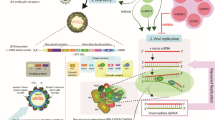Multiplication of poliomyelitis virus for vaccine production in 1955-1961 was realized in kidney cell culture from M. rhesus naturally infected with SV-40 simian virus. Hence, some lots of the vaccine were contaminated with this virus. It was found that SV-40 is oncogenic for laboratory rodents. Since 1963, in accordance with WHO recommendation, green monkey kidneys containing no SV-40 were used instead of M. rhesus kidneys. Overall vaccination of the population with poliomyelitis vaccine in 1955-1961 led to infection of many humans in Russia and many foreign countries with SV-40. The possibility of horizontal transmission of the virus was demonstrated. As a result, virus (its DNA sequences) was detected in individuals who were never vaccinated. Hundreds of reports, often contradictory, discuss this problem. Our study is based on the analyses of 460 blood specimens from subjects living in different regions of Russia (Krasnodar region, Moscow, Novosibirsk region, Krasnoyarsk territory). The percent of individuals infected with SV-40 varies from 16 to 49%.
Similar content being viewed by others
References
B. A. Lapin and M. G. Chikobava, Vestn. Rossiisk. Akad. Med. Nauk, No. 4, 7-10 (2009).
L. L. Mironova, V. D. Popova, and O. I. Konyushko, Proceedings of All-Russian Scientifi c Conference <<Prospective Trends of Using Laboratory Primates in Biomedical Studies>> [in Russian], Sochi-Adler, August 8-10, 2006, P. 121-125.
M. Carbone, P. Rizzo, and H. I. Pass, Oncogene, 15, No. 16, 1877-1888 (1997).
R. Cutrone, J. Lednicky, G. Dunn, et al., Cancer Res., 65, No. 22, 10,273-10,279 (2005).
T. Dang-Tan, S. M. Mahmud, R. Puntoni, and E. L. Franco, Oncogene, 23, No. 38, 6535-6540 (2004).
A. De Rienzo, M. Tor, D. H. Sterman, et al., J. Cell. Biochem., 84, No. 3, 455-459 (2002).
A. Gazdar and J. S. Butel, Nat. Rev. Cancer, 2, 957-964 (2002).
V. P. Grachev, G. G. Karganova, A. A. Rumyantsev, et al., Dev. Biol. (Bazel), 105, 211-217 (2001).
S. Heinsohn, S. Golta, H. Kabisch, and U. zur Stadt, Haematologica, 90, No. 1, 94-99 (2005).
A. Hirvonen, K. Mattson, A. Karjalainen, et al., Mol. Carcinog., 26, No. 2, 93-99 (1999).
G. Klein, A. Powers, and C. Croce, Oncogene, 21, No. 8, 1141-1149 (2002).
M. Wong, J. S. Pagano, J. T. Schiller, et al., J. Natl. Cancer Inst., 94, No. 24, 1832-1836 (2002).
Author information
Authors and Affiliations
Corresponding author
Additional information
Translated from Byulleten’ Eksperimental’noi Biologii i Meditsiny, Vol. 148, No. 12, pp. 687-689, December, 2009
Rights and permissions
About this article
Cite this article
Lapin, B.A., Chikobava, M.G. Epidemiology of SV-40 Simian Virus in Different Regions of the Russian Federation. Bull Exp Biol Med 148, 924–926 (2009). https://doi.org/10.1007/s10517-010-0853-z
Received:
Published:
Issue Date:
DOI: https://doi.org/10.1007/s10517-010-0853-z




